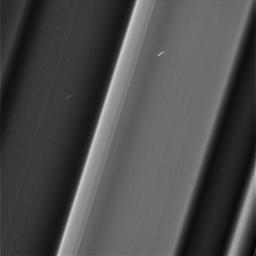
|
Textures in the C Ring
- Click the image above for a larger view
- Full-Res JPEG (1024 x 1024) (56.5 kB)
- Full-Res TIFF (1024 x 1024) (980.5 kB)
Caption:

Figure 1
Click on the image for larger version
Recent images of features in Saturn's C ring called "plateaus" have deepened the mystery surrounding them. It turns out that these bright bands have a streaky texture that is very different from the textures of the regions around them.
(See PIA03550 for a labeled diagram of the rings, and see PIA06540 and PIA08855 for more distant views of the C ring and its plateaus.)
The central feature in this image, called Plateau P1, is found approximately 47,300 miles (76,200 kilometers) from Saturn's center. It is situated amid some undulating structure that characterizes this region of the C ring. None of this structure is well understood.
This image, especially the enhanced version (Figure 1), reveals three different textures with different kinds of structure. The plateau itself is shot through with elongated streaks, while the brighter parts of the undulating structure have more clumpy texture that is similar to the "straw" seen previously in the A ring (see PIA21060 ), and the dimmer parts of the undulating structure have no apparent texture at all. These textures provide information about different ways in which the ring particles are interacting with each other, though scientists have not yet worked out what it all means.
Plateau regions are brighter than their surroundings, and have sharp edges. Recent evidence indicates that the plateaus do not actually contain more material than their surroundings, nor are they different in their chemical composition, which would mean that their greater brightness is likely due to smaller particle sizes. (If a given amount of mass is broken into smaller particles, it will spread out more [i.e., it will have more surface area].) These texture differences may give a clue about processes at the particle level that create the larger structures that Cassini has observed from greater distance throughout its mission at Saturn.
These images were taken with the camera moving in sync with the orbits of individual ring particles. Therefore, any elongated structures are truly there in the rings, and are not an artifact of particles moving during the exposure (i.e., smear).
In order to create the enhanced image (Figure 1), the large-scale brightness structure of the first image was averaged and then subtracted. What remains are any compact or local structures, including the textures discussed above. Also more visible in the enhanced image are small blemishes, including long, thin vertical lines that come from defects in the camera and short slanted lines that are smeared stars.
This image was taken on June 4, 2017, with the Cassini spacecraft narrow-angle camera. The image was acquired on the sunlit side of the rings from a distance of 32,206 miles (51,830 kilometers) away from the area pictured. The image scale is 1,070 feet (325 meters) per pixel. The phase angle, or sun-ring-spacecraft angle, is 80 degrees.
Background Info:
The Cassini mission is a cooperative project of NASA, ESA (the European Space Agency) and the Italian Space Agency. The Jet Propulsion Laboratory, a division of Caltech in Pasadena, manages the mission for NASA's Science Mission Directorate, Washington. The Cassini orbiter and its two onboard cameras were designed, developed and assembled at JPL. The imaging operations center is based at the Space Science Institute in Boulder, Colorado.
For more information about the Cassini-Huygens mission visit https://saturn.jpl.nasa.gov and https://www.nasa.gov/cassini . The Cassini imaging team homepage is at https://ciclops.org .
Cataloging Keywords:
| Name | Value | Additional Values |
|---|---|---|
| Target | Saturn Rings | C Ring, Saturn |
| System | Saturn | |
| Target Type | Ring | Planet |
| Mission | Cassini-Huygens | |
| Instrument Host | Cassini Orbiter | |
| Host Type | Orbiter | |
| Instrument | Imaging Science Subsystem (ISS) | |
| Detector | Narrow Angle Camera | |
| Extra Keywords | Clump, Grayscale, Visual | |
| Acquisition Date | ||
| Release Date | 2017-07-24 | |
| Date in Caption | 2017-06-04 | |
| Image Credit | NASA/JPL-Caltech/Space Science Institute | |
| Source | photojournal.jpl.nasa.gov/catalog/PIA21618 | |
| Identifier | PIA21618 | |
